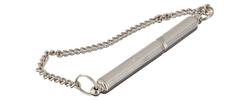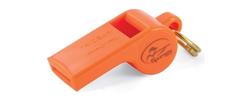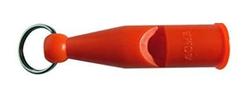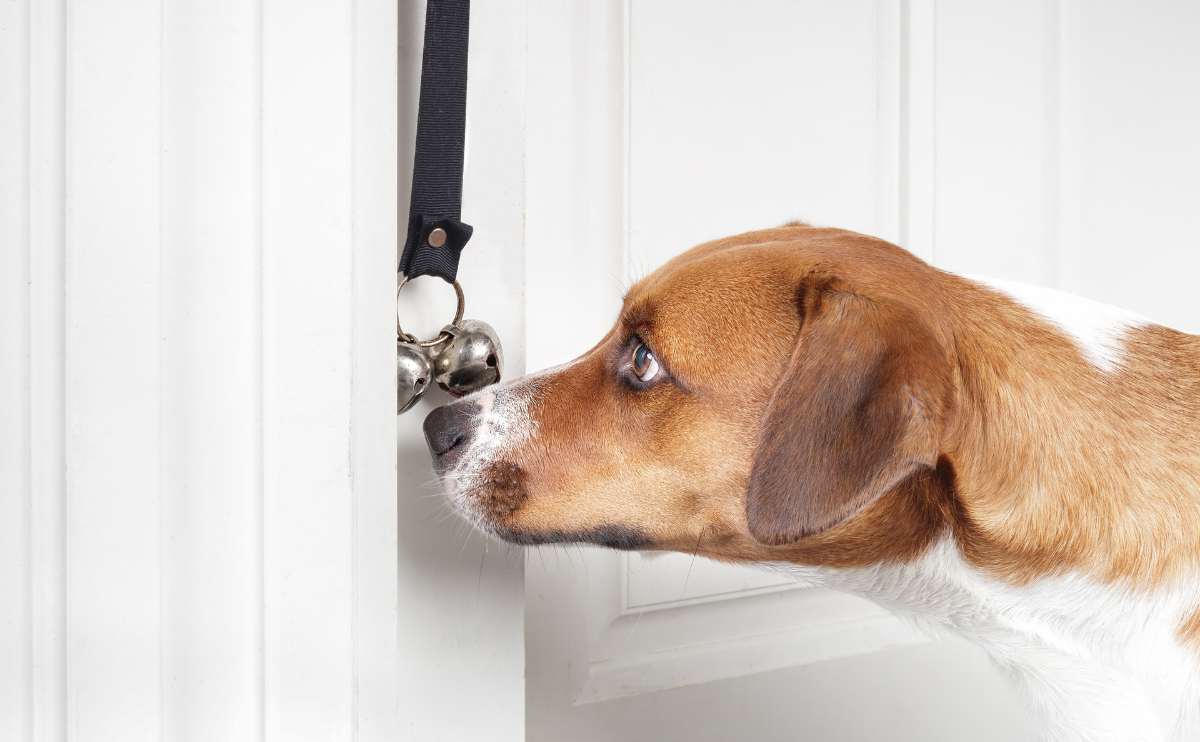When you purchase through links on our site, we may earn a commission. Here’s how it works.
If you’re contemplating using a dog whistle to train your pup, we’re here to help. We give you some guidance on when and how to use a dog whistle effectively, tips on how to whistle train your pup, teach you what do dog whistles do, explain dog whistle hz frequency, how to whistle train your dog, as well as our top picks for the best dog training whistles.
At-A-Glance: Our Top Picks
| Best Silent | Best Audible With Pea | Best Audible Pealess |
|---|---|---|
 |  |  |
| Acme 535 | SportDog Roy Gonia | Acme 212 |
| View on Amazon | View on Amazon | View on Amazon |
| Read Review | Read Review | Read Review |
When And How To Use A Dog Whistle

A dog whistle can be a great tool to get your pup to follow your commands, especially across long distances or noisy areas. While they’re commonly used with herding, hunting, and police dogs, dog training whistles are also helpful for many pet parents with everyday purposes — to get your dog to stop barking, recall, modify undesirable behaviors, and obedience training.
Types Of Dog Whistles
There are two basic types of dog whistles: audible and silent.
Audible
Many people find audible whistles more effective to use because you can easily hear the whistle blasts. Some audible dog whistles have a ball inside of them (called a pea or pearl) that allows you to make more sound variations, like trills. This can be helpful if you want to assign commands to different sounds rather than just the number of whistle blows. However, it’s important to know that the pea freezes up in cold weather, making the whistle useless.
Silent
Silent dog whistles use higher “ultrasonic” frequencies that are loud and easy for dogs to hear. While silent dog whistles may be better to use in dog parks or when you’re around other people, keep in mind that most silent whistles aren’t entirely silent for humans. They’re just not as loud to the human ear as audible whistles.
Best Dog Training Whistles
We’ve chosen our top picks based on each whistle’s quality and performance, as well as user feedback.
Best Silent: Acme 535 Silent Dog Whistle Review

If you’re looking for the best silent dog whistle, the Acme 535 is a top contender. It has an adjustable frequency, between 5,800Hz and 12,400Hz, that you set with the pitch register. While it’s not very audible for humans, dogs can hear it up to 400 yards away. Made of solid brass and nickel plating, it’s much more durable than plastic whistles. We also think it’s one of the best dog whistles to stop barking.
| Pros | Cons |
|---|---|
| High-quality material | Expensive for a dog whistle |
| Can be heard 400 yards away | Cap doesn’t stay on well |
| Adjustable frequency to fit what works best with your dog | |
| Attached cap to keep the mouthpiece clean |
Price
Best Audible With Pea: SportDOG Brand Roy Gonia Special Whistle Review

The SportDog Roy Gonia whistle has been the go-to dog whistle in Retriever training for years and is still commonly used in field dog training and by professional dog trainers. It has a lower-pitched, pea “trill” sound that carries across a good distance. And the pea design gives you more sound variations.
You can also opt for the SportDog whistle without a pea if you prefer a higher-pitched, no-trill sound that’s excellent for puppies and close-range training. And it won’t freeze in cold weather.
| Pros | Cons |
|---|---|
| Easy-to-blow design | Pea freezes in very cold weather |
| Low-pitch sound is easy for trainer to hear | Some customer complaints that it’s not loud enough |
| More sound variations | |
| Has a key-ring/lanyard connector |
Price
Best Audible Without Pea: Acme 212 Dog Training Whistle Review

Another quality product from Acme, this pealess dog whistle holds the same medium-pitch frequency no matter how hard you blow it. It’s excellent over long distances, making it one of the best dog whistles for recall. According to Acme, it works well with Pointers, Setters, Retrievers, and most Terriers. It’s also a great tool for harder-to-train dogs, heavy cover areas, and wind noise.
| Pros | Cons |
|---|---|
| Excellent for recall | Not all dogs respond to this single frequency whistle |
| Holds same frequency | |
| Medium-pitch sound is easy for trainers to hear but not too loud | |
| Made with very durable plastic |
Price
What About FOx & Ortz?
Here are some of our other picks for the best dog whistles, whether you need a more affordable silent whistle or a loud audible whistle.
Fox 40 CMG Mini Whistle Review

If you plan on using a whistle for recall when you’re hiking, camping, hunting, or other wilderness activities, you’ll need a loud whistle, like the Fox CMG Mini, that can cut through dense woods, the sound of streams, high winds, etc. This pealess whistle produces 115 decibels of high-pitched sound that your dog can hear up to a mile away. It even works well when it gets wet in the rain.
| Pros | Cons |
|---|---|
| Loud whistle – best for wilderness use | Too loud to use in populated areas |
| Dogs can hear up to a mile away | May be too startling for anxious dogs |
| Cushioned mouthpiece | |
| Compact, lightweight design | |
| Comes with a breakaway neck lanyard |
Price
Ortz Ultrasonic Dog Whistle Review

This Ortz dog whistle is a more affordable option if you want a “silent” dog whistle. Like the Acme 535, you can adjust the frequency to a pitch your dog responds to best. The range is about the same as a regular whistle but not as far as the Acme silent whistle, but it’s effective for close-range situations like at home, on walks, or at the dog park. As with most “silent” dog whistles, it’s not entirely inaudible to the human ear.
| Pros | Cons |
|---|---|
| Durable design | Limited range compared to the Acme 535 |
| Adjustable frequency to fit what works best with your dog | Several complaints that it doesn’t come with instructions on how to change the frequency |
| Comes with a neck lanyard | |
| Money-back guarantee |
Price
How To Whistle Train A Dog
The key to using a dog whistle is getting your dog to associate verbal commands like sit, stay, stop, and come with a distinct whistle blow — either a different sound or a series of repetitive blows. The most common dog training whistle commands are one blast for “sit” and three blasts for “come” or “here,” but you can set your own. Just remember to be consistent.
Has Your Dog Mastered Verbal Commands?
First, make sure that your dog responds to and obeys your voice commands correctly and quickly. If your dog hasn’t mastered the commands you plan to use, then you’ll have to work on every command until he does.
Choose Your Whistle Frequency
Dogs vary in how they respond to different frequencies. So if you’re using a silent whistle with an adjustable frequency, you’ll need to pick a frequency that works best for your dog. The easiest way to do this is by testing out your whistle frequency on your pup while he’s sleeping. If he wakes up when you blow the whistle, it’s a good indication that he’ll respond to it when awake.
It’s Time To Whistle Train
- Start slowly in an area without many distractions, like in your home or yard.
- You start by saying the verbal command, use your chosen whistle sound, and then give the verbal command again.
- When your dog responds correctly, give him lots of praise and a treat.
- Repeat this process as many times as needed, gradually phasing out the verbal command.
- You’ll want to work on one command at a time until your pup has it down, and then you can move on to the next command.
How You Blow Your Whistle Matters (Video)
Check out this quick tip from a dog behavioral expert on how to blow your whistle to get your pup’s urgent attention.
Should I Use A Dog Whistle Or Sonic Training Device For Barking?

If your goal is to stop your dog from barking incessantly, training with a dog whistle or an anti-barking sonic training device can both help. Sonic anti-bark devices are typically hand-held devices where you push a button to alert your dog to stop barking. The training with this type of device is similar to whistle training, where you have to teach your dog to understand that you want him to stop barking when you press the button on the device.
These devices typically have a narrow ultrasonic frequency, so it’s hit or miss if your dog responds to the device you choose. We recommend the STOPWOOFER Ultrasonic Dog Training-Bark Control Device if you want to try one out.
Overall Dog Training Tips
Training your dog is one of the most important things you can do to have a well-behaved and happy pup — and it ultimately makes your life much easier in the long run and creates a strong bond between you and your dog. Whistle training is only one of many methods you can use to train your pup. Check out all the advice we have for training your pup, whether you want to train your dog yourself or find professional dog training.
Tagged With: Comparison, Training

